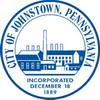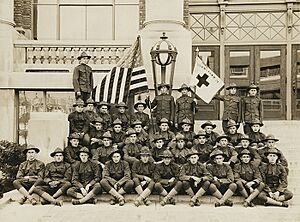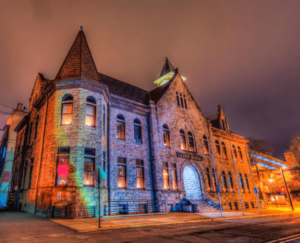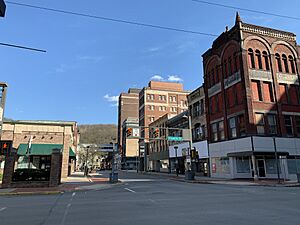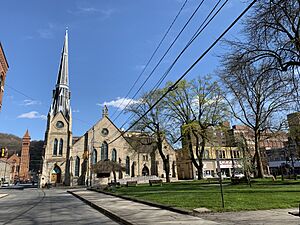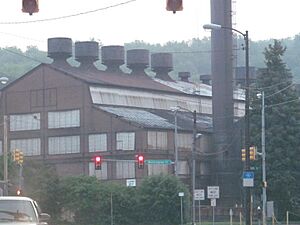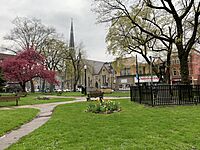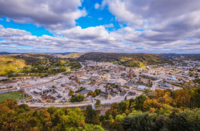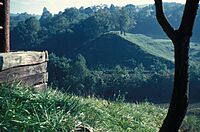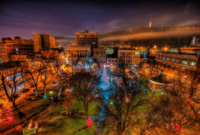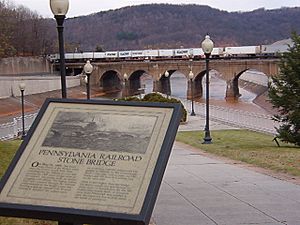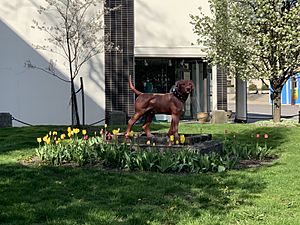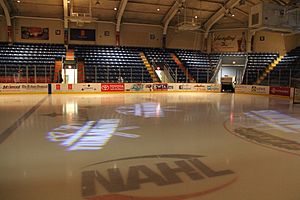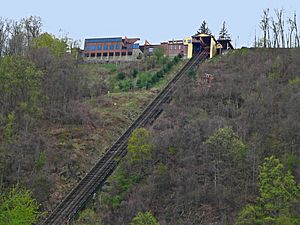Johnstown, Pennsylvania facts for kids
Quick facts for kids
Johnstown, Pennsylvania
|
|||
|---|---|---|---|
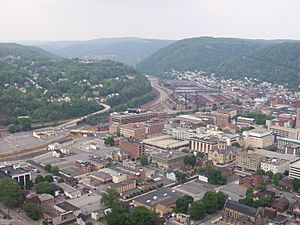
View of Johnstown from the Inclined Plane
|
|||
|
|||
| Nickname(s):
Woodchuck City
|
|||
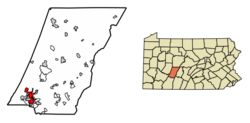
Location of Johnstown in Cambria County, Pennsylvania
|
|||
| Country | United States | ||
| State | Pennsylvania | ||
| County | Cambria | ||
| Founded | 1800 | ||
| Incorporated (borough) | 1831 (as Conemaugh) | ||
| Incorporated (city) | December 18, 1889 | ||
| Government | |||
| • Type | City Council | ||
| Area | |||
| • City | 6.111 sq mi (15.827 km2) | ||
| • Land | 5.913 sq mi (15.315 km2) | ||
| • Water | 0.198 sq mi (0.514 km2) | ||
| Elevation | 1,161 ft (354 m) | ||
| Population
(2020)
|
|||
| • City | 18,411 | ||
| • Estimate
(2023)
|
17,950 | ||
| • Density | 3,040/sq mi (1,172/km2) | ||
| • Urban | 61,521 (US: 444th) | ||
| • Metro | 130,668 (US: 313rd) | ||
| Time zone | UTC−5 (Eastern (EST)) | ||
| • Summer (DST) | UTC−4 (EDT) | ||
| ZIP Codes |
15901–15902, 15904–15907, 15909, 15915, 15945
|
||
| Area code(s) | 814 and 582 | ||
| FIPS code | 42-38288 | ||
| GNIS feature ID | 1215025 | ||
| Sales tax | 6.0% | ||
|
Pennsylvania Historical Marker
|
|||
| Designated: | October 1, 1947 | ||
Johnstown is the largest city in Cambria County, Pennsylvania, United States. In 2020, about 18,411 people lived there. It is located about 57 miles east of Pittsburgh. Johnstown is the main city of the Johnstown metropolitan area.
Once a busy industrial center, Johnstown faced challenges when many jobs moved overseas. This was similar to what happened in other cities in the Rust Belt.
Contents
History of Johnstown
Johnstown was first settled in 1770. The city has experienced three major floods in its history. The most famous was the Johnstown Flood on May 31, 1889. This happened after the South Fork Dam broke during heavy rains. The dam was about 14 miles upstream from the city. Over 2,200 people died from the flood and a large fire that followed.
Another big flood happened in 1936. Even though President Franklin Delano Roosevelt promised to make the city flood-free, and work was done, another major flood occurred in 1977.
Johnstown is home to several national historic districts. These include the Downtown Johnstown Historic District and the Cambria City Historic District. Many individual buildings are also listed on the National Register of Historic Places.
Early Years and Growth
Joseph Johns, a Swiss-German immigrant, formally planned Johnstown in 1800. It was first called "Conemaugh Old Town." The settlement was also known as "Schantzstadt" before its name became Johnstown.
The community officially became a borough called Conemaugh in 1831. It was renamed Johnstown in 1834. From 1834 to 1854, Johnstown was an important stop on the Pennsylvania Main Line Canal. Canal boats were carried over the mountains by the Allegheny Portage Railroad. Then, they were put back in the water in Johnstown to continue to Pittsburgh.
When the Pennsylvania Railroad was completed in 1854, canals became less important. The railroads helped the city grow even more. Johnstown became a stop on major railroad lines. This helped develop the region's rich mineral resources.
Steel and the 1889 Flood
Iron, coal, and steel quickly became very important to Johnstown. By 1860, the Cambria Iron Company in Johnstown was the top steel producer in the United States. It made more steel than big companies in Pittsburgh and Cleveland. In the late 1800s, Johnstown produced much of the nation's barbed wire. This was a very popular product in the western United States.
By 1880, the Cambria Works was a huge business. It covered 60 acres in Johnstown and employed 7,000 people. The company owned 40,000 acres of land rich in iron, coal, and limestone.
Floods were common in the valley during the 1880s. On May 30, 1889, after a quiet Memorial Day parade, it started raining heavily. The next day, water filled the streets. Rumors spread that a dam holding a lake in the mountains might break. It did, and about 20 million tons of water rushed towards Johnstown, 14 miles away.
The destruction in Johnstown happened in only about 10 minutes. A busy steel town with homes, churches, and businesses was buried under mud and debris. Out of about 30,000 people, at least 2,209 died. A major fire also broke out at the old stone Pennsylvania Railroad bridge. This bridge is still standing today where the Stonycreek and Little Conemaugh rivers meet.
The Johnstown flood of 1889 helped establish the American Red Cross as a leading emergency relief group in the U.S. Its founder, Clara Barton, came to Johnstown with doctors and nurses. She set up hospitals and temporary shelters and stayed for five months to help.
The steel mills were back in operation within a month. The Cambria Works grew, and Johnstown became even more successful. The disaster did not destroy the community; it made it stronger. Johnstown officially became a city in 1890.
20th Century Changes
In the early 1900s, Johnstown's population reached 67,000. The city's first commercial radio station, WJAC, began broadcasting in 1925. Downtown Johnstown had several large department stores.
However, the St Patrick's Day flood of 1936 and the Great Depression caused problems for Johnstown. Citizens asked President Franklin Roosevelt for federal help. In 1938, the U. S. Army Corps of Engineers started a five-year project. They widened and deepened 9.2 miles of river channel and lined the banks with concrete.
Professional ice hockey came to Johnstown in 1941. The Johnstown Jets later played an exhibition game against the Montreal Canadiens in 1951. After the river work, Johnstown was called "flood-free." This feeling was strong when the city avoided flooding during Hurricane Agnes in 1972.
After World War II, Johnstown was at its peak as a steel producer. Steel provided over 13,000 good jobs. But increased competition and Johnstown's distance from its iron ore sources led to a decline. New investments slowed down. The city's hilly land also made it hard to expand the mills.
New rules from the EPA in the 1970s also affected Johnstown. The old Cambria plant (then Bethlehem Steel) was hit hard. City leaders worked with the steel company to create Johnstown Area Regional Industries (JARI). They raised $3 million for industrial development. Bethlehem Steel was impressed and committed to bringing new steelmaking technology to Johnstown.
The 1977 flood caused major damage. There was talk of the steel company leaving. But the company's leaders, who liked the Johnstown works, gave the city another chance. However, with more environmental rules and aging facilities, steel companies began closing plants across the country. By the early 1990s, Johnstown stopped most of its steel production. Some limited metal fabrication still continues.
Johnstown in the 21st Century
In 2003, data showed Johnstown was less likely to attract new residents. However, local manufacturing and service jobs have grown, attracting new people. Gamesa Corporación Tecnológica, a Spanish wind energy company, opened a wind turbine blade factory nearby in 2006, but it closed in 2014.
Several wind turbines are now on Babcock Ridge. Lockheed Martin moved a facility to Johnstown in 2008. Höganäs AB, a Swedish company, operates two plants in the area. Companies like Concurrent Technologies Corporation and Kongsberg Defense are also thriving.
New construction, including a large Regional Technology Complex, shows Johnstown's economy now relies more on the U.S. government's defense budget. The high-tech defense industry is a main part of Johnstown's economy, bringing in over $100 million yearly in government contracts. The annual Showcase for Commerce is a top defense trade show in the U.S.
Johnstown remains a regional center for medicine, education, culture, and communication. Health care provides many jobs in the city. Major health care centers include Memorial Medical Center and Windber Medical Center.
The University of Pittsburgh at Johnstown and Pennsylvania Highlands Community College attract many students. The Pasquerilla Performing Arts Center at the University of Pittsburgh at Johnstown hosts high-quality performers. The Johnstown Symphony Orchestra provides classical music. The Johnstown Concert Ballet offers performances and training.
The Pasquerilla Convention Center was built downtown, next to the Cambria County War Memorial Arena. Point Stadium, a baseball park where Babe Ruth once played, was rebuilt. The Bottleworks Ethnic Arts Center celebrates the area's diverse cultures.
The Johnstown Chiefs ice hockey team played for 22 seasons. After they left, the city found a new team, the Johnstown Tomahawks of the junior North American Hockey League, who began playing in 2012.
The ART WORKS in Johnstown! project houses artist studios in old industrial buildings. The Frank & Sylvia Pasquerilla Heritage Discovery Center opened in 2001. It has an exhibit called "America: Through Immigrant Eyes," about immigration during the Industrial Revolution. In 2009, the center opened the Johnstown Children's Museum and showed "The Mystery of Steel," a film about Johnstown's steel history.
These centers are in the historic Cambria City section, known for its Eastern European churches. This neighborhood hosted the National Folk Festival in the early 1990s, which led to the Flood City Music Festival. Johnstown also hosts the annual Thunder in the Valley motorcycle rally in June. This event attracts over 200,000 motorcyclists.
Efforts are being made to improve housing and deal with other city issues. The Johnstown Fire Department is a national model for communication systems among first responders.
Geography of Johnstown
Johnstown is located in southwestern Cambria County, Pennsylvania. The city covers about 6.1 square miles, with most of it being land. The Conemaugh River forms in Johnstown where the Stonycreek River and the Little Conemaugh rivers meet.
-
View of the city of Johnstown from atop the Inclined Plane
Neighborhoods and Nearby Areas
Johnstown has many neighborhoods, each with its own unique feel. These include Downtown Business District, Kernville, Hornerstown, Roxbury, and Cambria City.
Nearby suburbs include Westmont, Southmont, and Richland Township. The borough of Dale is located inside Johnstown, between Hornerstown and Walnut Grove. Other surrounding areas include East Conemaugh, Franklin, and Stonycreek Township.
Climate and Weather
Johnstown has a climate with warm summers and cold winters. The average temperature in January is about 26 degrees Fahrenheit. In July, the average temperature is about 70 degrees Fahrenheit. The city receives a good amount of rain throughout the year.
Population and People
| Historical population | |||
|---|---|---|---|
| Census | Pop. | %± | |
| 1840 | 949 | — | |
| 1850 | 1,269 | 33.7% | |
| 1860 | 4,185 | 229.8% | |
| 1870 | 6,028 | 44.0% | |
| 1880 | 8,380 | 39.0% | |
| 1890 | 21,805 | 160.2% | |
| 1900 | 35,936 | 64.8% | |
| 1910 | 55,482 | 54.4% | |
| 1920 | 67,327 | 21.3% | |
| 1930 | 66,993 | −0.5% | |
| 1940 | 66,668 | −0.5% | |
| 1950 | 63,232 | −5.2% | |
| 1960 | 53,949 | −14.7% | |
| 1970 | 42,476 | −21.3% | |
| 1980 | 35,496 | −16.4% | |
| 1990 | 28,134 | −20.7% | |
| 2000 | 23,906 | −15.0% | |
| 2010 | 20,978 | −12.2% | |
| 2020 | 18,411 | −12.2% | |
| 2023 (est.) | 17,950 | −14.4% | |
| U.S. Decennial Census 2020 Census |
|||
In 2020, Johnstown had 18,411 people living in 8,574 households. About 66.8% of the population was White, and 20.4% was African American. About 4.2% of the population was Hispanic or Latino.
About 22.8% of residents were under 18 years old. About 19.5% were 65 or older. The median age was 41.8 years.
The average household income in 2013 was about $23,785. Many jobs in Johnstown are in health care, defense, and retail.
Economy and Jobs
When steel production decreased, coal mining in Pennsylvania also went down. This affected Johnstown's economy. In 1982, the city's income dropped by about 35 percent.
Johnstown's economy has since improved, mainly due to health care and high-tech defense industries. In 2018, Forbes magazine ranked Johnstown 169th among "The Best Small Places For Business And Careers" in the U.S.
Major employers in the area include:
- American Red Cross
- AmeriServ Financial
- Arthur J. Gallagher & Co.
- Atlantic Broadband
- Berkshire Hathaway—Penn Machine
- Concurrent Technologies Corporation
- Conemaugh Health System
- Concentrix
- Crown American
- DRS Technologies
- Galliker's
- Höganäs AB
- Kongsberg Gruppen
- Lockheed Martin
- Martin-Baker
- Metropolitan Life
- Northrop Grumman
- Pepsi Bottling Group
- Zamias Services, Inc.
Arts and Culture
Important Landmarks
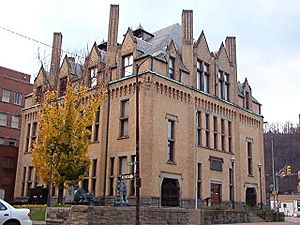
- Cambria County War Memorial Arena: A popular venue for sports and events.
- Cambria Iron Company: A National Historic Landmark and a symbol of Johnstown's industrial past.
- Famous Coney Island Hot Dogs: An eatery founded in 1916, known for its hot dogs.
- Frank & Sylvia Pasquerilla Heritage Discovery Center: Features exhibits on immigration and the history of steel. It also has the Johnstown Children's Museum.
- Johnstown Flood National Memorial: A National Park Service site that protects the remains of the South Fork Dam.
- Johnstown Flood Museum: Shows an Academy Award-winning film about the 1889 flood.
- Johnstown Inclined Plane: The world's steepest vehicle inclined plane, offering great views of the city.
- Point Stadium: A historic baseball park.
- Staple Bend Tunnel: The first railroad tunnel built in the United States.
- The Stone Bridge: A historic railroad bridge that survived the 1889 flood.
Events and Festivals
Johnstown hosts several events each year. The "Rumble Through the Valley" motorcycle rally will start in June 2025.
The AAABA amateur baseball tournament is held at Point Stadium. The Flood City Music Festival takes place at Peoples Natural Gas Park. It has featured famous musical acts.
The Sunnehanna Amateur golf tournament is held yearly. Famous golfers like Tiger Woods and Arnold Palmer have played in it as amateurs.
Sports in Johnstown
| Club | League | Venue | Established | Championships |
|---|---|---|---|---|
| Johnstown Mill Rats | Prospect League (baseball) | Point Stadium | 2021 | 0 |
| Johnstown Tomahawks | NAHL (ice hockey) | Cambria County War Memorial Arena | 2012 | 0 |
Johnstown has a long history with minor league hockey teams since 1940. The Johnstown Chiefs were a well-known team. In 2012, the Johnstown Tomahawks of the junior North American Hockey League began playing in Johnstown.
The city also has a history with amateur and professional baseball. Since 1944, Johnstown has hosted the AAABA Baseball Tournament every summer. Many Major League Baseball players, including Hall-of-Famers Al Kaline and Reggie Jackson, have played in this tournament.
The Johnstown Mill Rats, a summer college baseball team, have played at Point Stadium since 2021. Johnstown also hosts the annual Sunnehanna Amateur golf tournament.
Kraft Hockeyville USA Contest
On May 2, 2015, Johnstown won the 2015 Kraft Hockeyville USA contest. The city received $150,000 for improvements to the Cambria County War Memorial Arena. As part of the prize, the arena hosted an NHL pre-season game on September 29, 2015. The Pittsburgh Penguins played against the Tampa Bay Lightning, with the Penguins winning 4-2.
Government and Education
The Johnstown City Hall is located at 401 Main Street. The mayor of Johnstown is Frank Janakovic.
Colleges and Schools
- University of Pittsburgh at Johnstown: A university located just outside the city.
- Pennsylvania Highlands Community College: Offers various programs for students.
- Christ the Saviour Seminary: A religious education institution.
The Greater Johnstown School District serves students in Johnstown and nearby townships. It includes a pre-school, elementary school, middle school, and high school. Bishop McCort High School is a private Catholic high school.
The Greater Johnstown Career and Technology School offers career training. The Cambria County Library is located downtown.
Transportation and Services
The main highway connecting Johnstown to the Pennsylvania Turnpike is U.S. Route 219. PA Route 56 connects to U.S. Route 22, which leads to Pittsburgh and Altoona.
The local airport is the John Murtha Johnstown-Cambria County Airport. It has flights to Washington-Dulles and Chicago-O'Hare.
Amtrak provides passenger train service at the Johnstown Amtrak station. The city is on the former main line of the Pennsylvania Railroad.
CamTran operates the local bus service and the Johnstown Inclined Plane (a special railway that goes up a steep hill).
Emergency Services
The Johnstown Fire Department has teams for hazardous materials and water rescues. They also teach fire safety classes. The Johnstown Police Department has 35 full-time officers.
Notable People from Johnstown
- Alex Azar: Former U.S. Secretary of Health and Human Services.
- Carroll Baker: Oscar-nominated actress.
- Donald Barlett: Journalist and two-time Pulitzer Prize winner.
- Steve Ditko: Comic book artist and co-creator of Spider-Man.
- Jack Ham: Pro Football Hall of Fame linebacker.
- Tim Kazurinsky: Comedian and actor from Saturday Night Live.
- John Murtha: U.S. congressman.
- Joe Pass: Famous jazz guitarist.
- Ray Scott: Sportscaster.
- Russell Shorto: Author.
- Emil Sitka: Actor, known for his roles with the Three Stooges.
- Michael Strank: World War II hero, pictured in the Iwo Jima flag raising photo.
See also
 In Spanish: Johnstown (Pensilvania) para niños
In Spanish: Johnstown (Pensilvania) para niños



